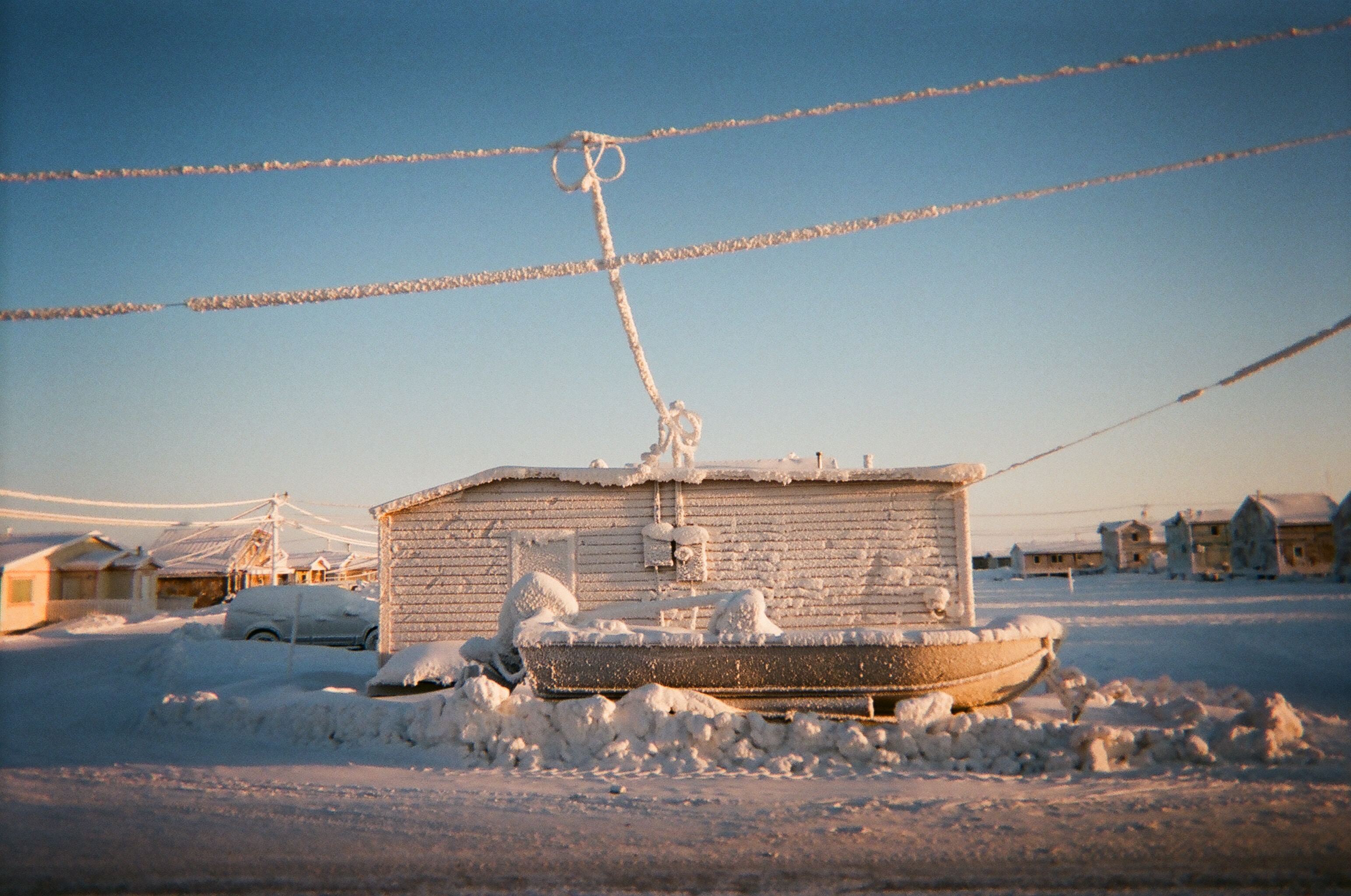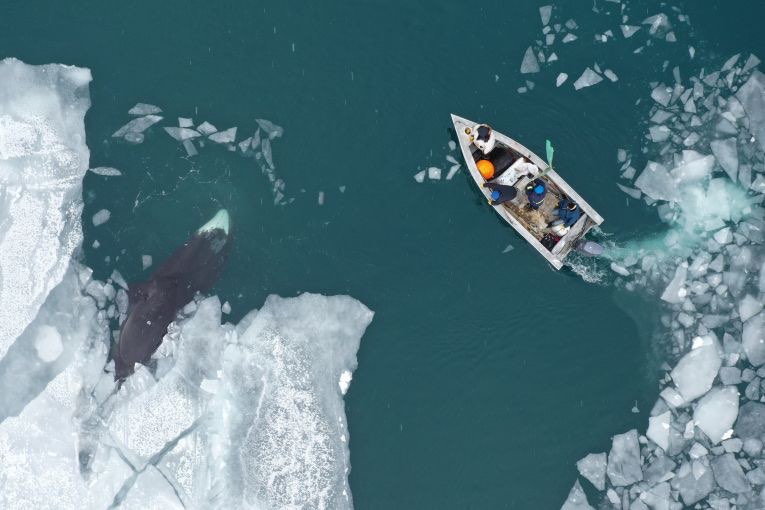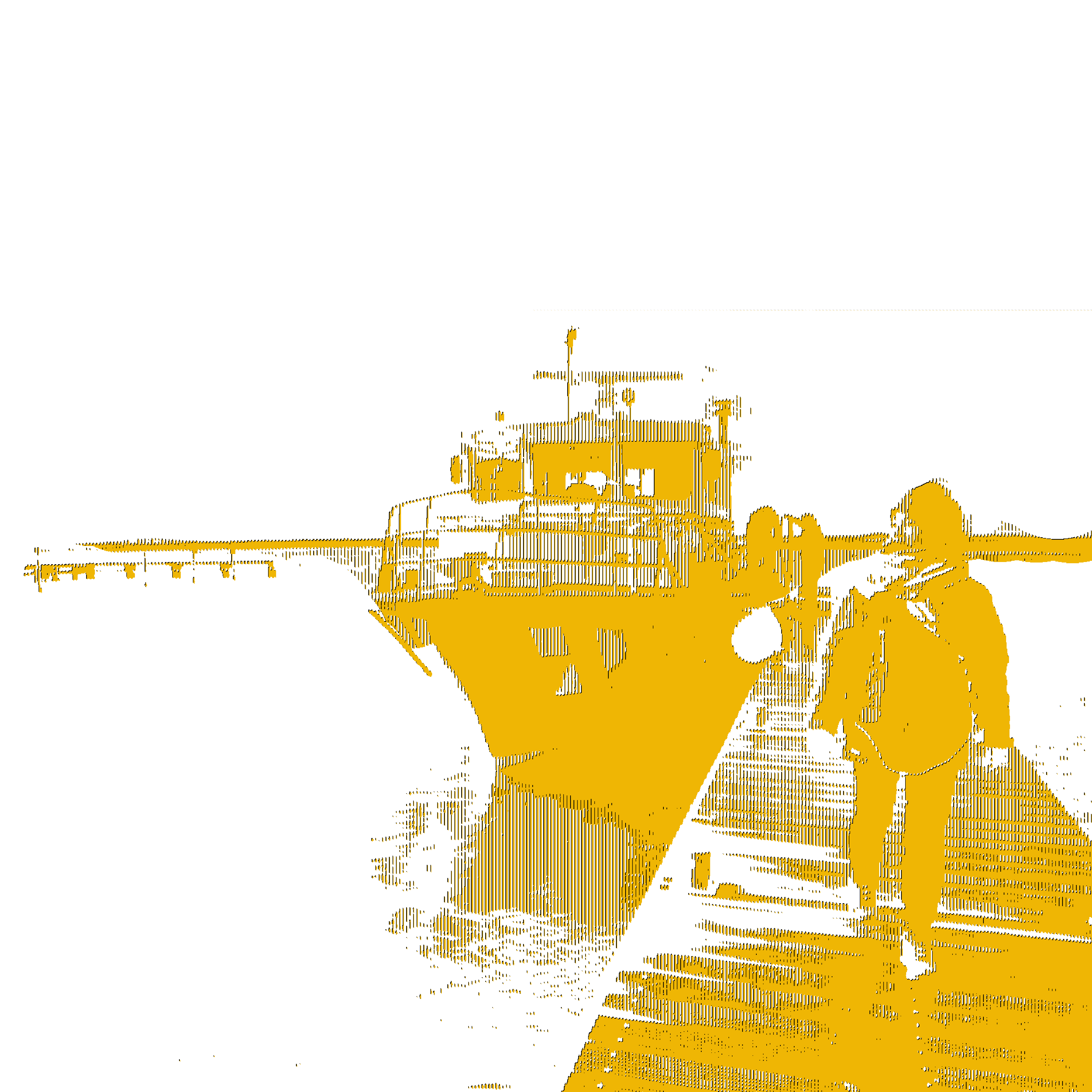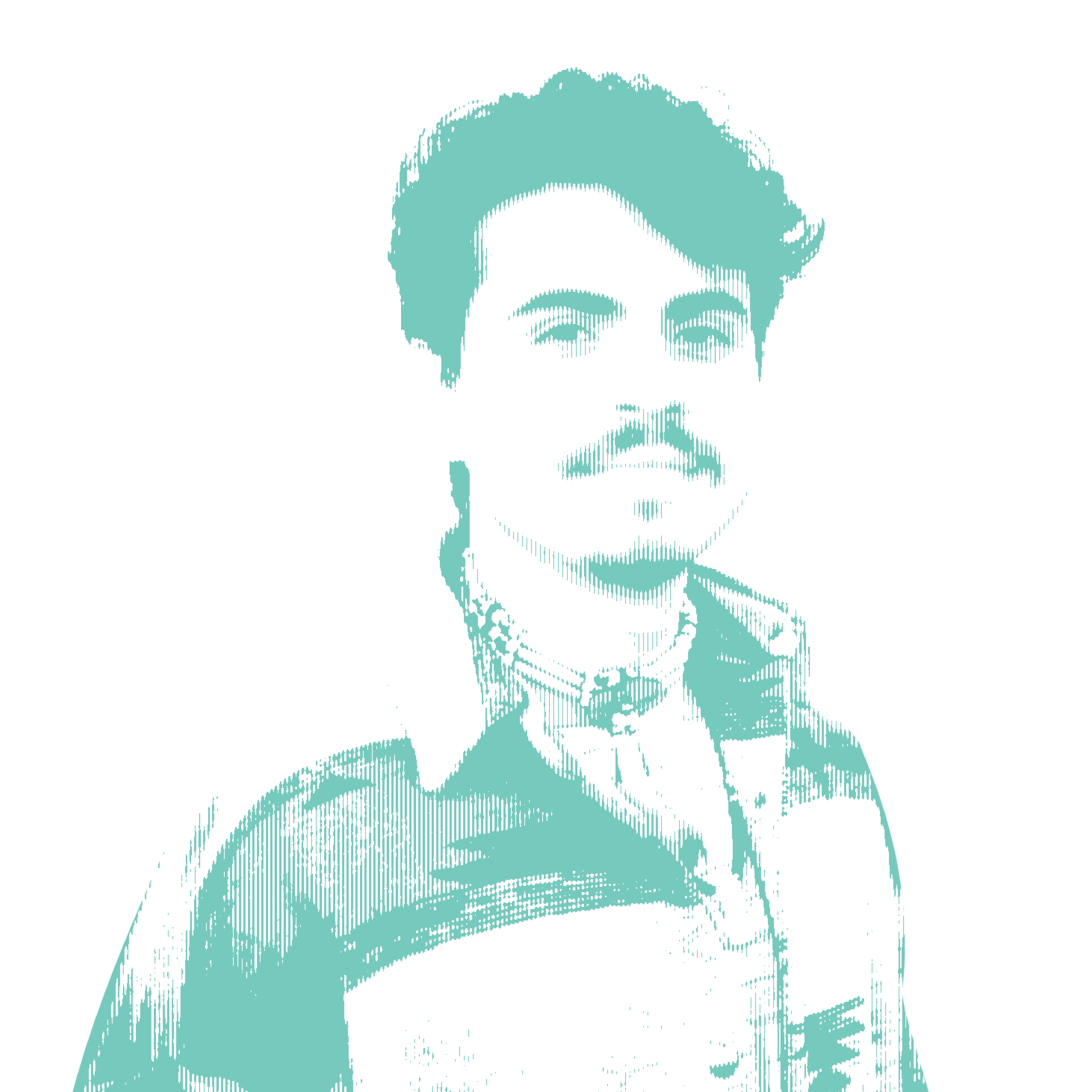
In January 2020, right as the sun was returning after the long polar night, podcaster and Iñupiaq Alice Qannik Glenn and reporter Jenna Kunze arrived in Utqiaġvik, the northernmost city in the United States. Glenn and Kunze collaborated on the Connected Coastlines-supported project Alaska Natives on the Front Line to explore how the community is adapting to a rapidly changing environment.
Alaska is warming at twice the rate of the global average, according to climate scientists. Particularly affected communities are coastal Alaska Natives who rely on freezing temperatures to travel, hunt, and maintain traditional lifestyles. Glenn, who grew up in Utqiaġvik, published long-form interviews on her podcast, Coffee and Quaq, which delves into the various aspects of how Iñupiat life has changed and remained the same.
In Kunze’s article, “‘What Choice Do We Have?’,” Kaare Sikuaq Erikson, an Iñupiaq science liaison at the village corporation, says, “People assume that we’re entering this new Arctic, when in reality we have faced adversity for thousands of years. We’ve always been able to adapt and be resilient. This is no different.”
Kunze and Glenn take a multifaceted approach to reporting on resilience in Utqiaġvik. They spoke with Pulitzer Center intern Abigail Gipson about how their collaboration began and what they learned in the process.
Abigail Gipson: How did you come up with the idea for this project? How did you decide to work together?
Jenna Kunze: I’m the one who sort of wrangled Alice into the project. I was a reporter in Southeast Alaska for about a year and a half when I originally read about the Pulitzer Center’s Connected Coastlines grant opportunity. Because the nature of my reporting there had to do with climate issues and the many ways that Alaska specifically is affected so significantly by small changes in the environment, I thought that it would make sense to apply and go as far north one possibly can go and be in the United States, which is Utqiaġvik. And that's how I learned about Alice. She had been covered in the local newspaper as a new podcaster on the scene. She's from Utqiaġvik, and a lot of her reporting deals with contemporary issues that urban Natives face. And so it seemed like a natural fit. And so I reached out to her on a whim really, maybe the day or two days before the application was due, and I asked her if she wanted to partner with me. I think at first she was a little scared, and then we talked and she agreed. She made it really clear from the beginning that she wanted it to be a story of empowerment and hope, focusing on solutions.
Alice Qannik Glenn: Jenna had reached out to me over social media saying that she had this grant that she was interested in applying for, and would I be open and willing to collaborate with her. At first, I was a little bit apprehensive because it's not just a dot on a map, you know, that's my hometown. I just felt a lot of responsibility in how we tell this story and to make sure that it comes out in a sense of empowerment rather than this gloom and doom, “we're going to be gone in in 50 years” type of language that I had been seeing, that everyone sees in all of these news outlets. But then we met over Zoom and I fell in love with Jenna, and I felt like she would honor this story as much as I would. We started having weekly meetings and trying to plan out when a good time would be to go. And we wanted to go not during polar night. Thankfully, that was before COVID hit. Also, we had never met in person before until the flight to Utqiaġvik. So we're like, "Oh, hi, nice to meet you. Nice to meet you in person, you know, here we are, going to the northernmost city in the United States.”
JK: We met on the plane.
AQG: I was just really impressed that she was up for that kind of adventure, really.
JK: Actually the day that we arrived was the first day that the sun came back, which we had planned.
AG: What did this partnership look like while you were reporting? Because, Alice, you were doing audio reporting, and then, Jenna, you were doing print reporting. So how did you report for your separate mediums, but on one reporting journey?
JK: The format that our interviews took was we found the people we wanted to speak with and formed questions together ahead of time. The interviews we did together. Alice took the lead because a hundred percent of the time, Alice knew, had grown up with, gone to school with them or with the kids of the people we were interviewing. And so, that was the way that we approached it. And then with that audio of the interviews, I was able to write the larger piece, and I had done maybe an additional 10 or so interviews in the month or so by myself there. And then what Alice is publishing on her podcast are the actual interviews themselves.
I could not have done this project without Alice, and not just because she knew people. Not just because I was sleeping at her mom’s house. I just wouldn’t have been able to have the clout. Utqiaġvik is pretty insular, and a lot of people have been misrepresented by media in the past. Coming in, even though I was there almost two months, when Alice left I had to be like, “I’m friends with Alice Glenn!” But also just her perspective from having grown up there. Having her insider perspective versus my outsider perspective paired together was critical for this. And of course her being Alaska Native, the project couldn’t have been done without that perspective.
AQG: Yeah, it was really cool to go home and to experience it again through new eyes. It really was the perfect pairing for a project like this.
AG: Alice, I wanted to ask you about the podcast you did about the water system and wastewater in Utqiaġvik. I was really gripped by this story, and I realized how much I don't know about how anything works where I live. So, what drew you to this topic that maybe a lot of us forget about sometimes?
JK: Alice had the same reaction as you of, “Oh, I didn't realize how these things work.” I think that's a normal takeaway from listening to this.
AQG: Yeah because Jenna asked, “Where do you get your water from?” I was like, “From the sink? I don't know!” So, what we were thinking about is, what are two big factors of climate change in the Arctic? One is coastal erosion and one is permafrost thaw. And so how does that affect infrastructure in general? One of our roads is eroding away in Barrow, and it's right next to one of the water and sewer pumps, a main one. I had no idea, and I'm sure Jenna didn't either, about what that would cost [to repair], or how much did it cost to even install, in permafrost. And so we were learning those things together. I think that there are just unique adaptations that the Iñupiaq have that people don't always recognize or think about.
And so it was important for me to share that we have infrastructure, we have economy, we have different things going on in our town. It's just going to require some adapting and rethinking and remapping, with climate change.
JK: What I was impressed by and the biggest takeaway for me was adaptation. Once Alice and I started looking at the different ways that the Iñupiaq have adapted for thousands of years, it became all we saw. We're only seeing adaptation to live in this harsh climate. All of the simple ways that aren't simple, when you have limited resources, it's really rural, and it's really expensive to build or to get a lot of things going up there. So I think that I was interested in the story because I suspected that that was true, but I didn't know for sure. And I wanted to know. And just to do the story justice, to represent it from a more Iñupiaq-centered perspective.
AG: In the radio interview you did with KNBA, you were talking about these media stereotypes that you had encountered in a lot of coverage of the area and how this story was a way to shift the narrative into one of hope and resilience. Could you expand a little bit on your approach to achieving that in your reporting?
AQG: I think that one of the biggest parts of that approach was in creating the questions. We had one question that we really wanted to ask everyone and it was, "What kinds of things have remained the same?" You know, because everyone is always asking about what's changing. “How is this being affected?” “How is your life changing?” But nobody ever takes the time to think about what kinds of things are constant, what kinds of things have stayed with us for thousands of years and that we don't expect to change in thousands of years.
I don't think we set out to change the narrative. That wasn't my intention. I think people are always going to write what they want to write about wherever in the world. But for me personally, this isn't just a narrative. It's my life. It's my people. So I just wanted to represent that to the fullest. And for it to be something for Iñupiaq people to be proud of and for other people to be interested in. I'm only one person. I just felt like it was important for me as an Iñupiaq woman to represent my community and myself as best as I can.
JK: The narrative sort of shaped itself. I mean, it very much shaped itself. So, we had come up with a framework of questions that we asked in interviews with various community members, from whalers to people that work in infrastructure, to the mayor. And it was just really impressive to me how the answers all chorused each other. So it wasn't even a question, the focus of the story really came forward when everyone said, "Our culture has remained the same, that is steadfast. The fact that we are always changing has remained the same." It wasn't just one person who said that, it was every single person.
AG: Has reporting this project affected any of the future work that you hope to do?
JK: From this project, Alice and I have done another project together. We got invited to report on sexual assault against women in Nome in western Alaska, and how that has been mishandled, how Alaska Native women fall through the cracks of the criminal justice system. And so while that project is a different focus than climate change, I think there are things at its core that are the same. Almost all of these issues can be tied directly to imperialism—just cycles of underfunding and inherent racism. I think all of those things are closely related. And so that has informed our latest project, which is in partnership with a local radio station, KNOM, in Nome.
AQG: I think that there are some correlations between the ideas of women's bodies and the environment, this idea of extraction. Nome was a huge gold mining place, for a while. It's also a place where some Iñupiaq believe we originated as Iñupiaq people. And so I think there are a lot of correlations between the environment and the sanctity of women's bodies, and I was just shocked that that was happening to our people.
AG: Reading and listening to your work, I was struck by these competing ideas of sustainability and by the question of what is sustainable and for who. I was just curious if you had any thoughts or things that you learned throughout your reporting about this.
AQG: Jenna and I had so many conversations about that while we were in Utqiaġvik. I knew that this was going to be a little bit of a hot button issue for me, as an Iñupiaq woman, because a large amount of our economy comes from resource development. We know that resource development is nonrenewable, it's not sustainable in the long run, it has different factors on the environment and all of these things are contributing to climate change. But that being said, I think the Iñupiaq don't have the luxury to just change that in a matter of five years.
Nobody else is going to take care of us as best as we can take care of ourselves. So there's some self-determination in that. And I struggle with that, I struggle internally. But also, the only reason that I'm able to think about these things and how we can move forward is because I've been granted the luxury and the education and the safety, all of those things, provided to me through resource development. So, I wouldn't be who I am today without having that access and that economy.
There's a lot of pride that we carry in ourselves as Iñupiaq people, living in one of the harshest environments in the world and still being able to thrive. Not just survive and get through the day, but also to be someone like me in media, and to create and carry those values forward.
So, it's complicated. But I don't think that we should shy away from the conversation just because it's complicated, it's nuanced. And I just hope that people understand that.
JK: Going into this project, I had preconceived notions of what it means to have your lifestyle subsidized by the oil and gas industry and what that does to your opinion about resource extraction. But then I constantly had to think and rethink through it. Speaking to the older generation of elders, who are just people in their sixties, like Mayor [Harry] Brower—he grew up without running water or electricity. I think the question of what is sustainable and for who, it really needs to be answered regionally. And especially for drilling and resource extraction that is coming from, I mean, like 25 percent of America's oil comes from Prudhoe Bay in the Arctic.
I think that the Iñupiaq people that live there should have a larger say in what happens. For example, this past winter, when I was in Utqiaġvik, a lot of banks had pulled out of further developing the Arctic. They don't want to do drilling there, even though there are known to be resources under the ground because they took a stance as though it was for environmental reasons, which is almost laughable because they're a huge corporation. They're not doing anything for environmental reasons. It seemed very political to me. And I was in a meeting with the mayor and people, predominantly men, who sit on the assembly, older whaling captains, so they, again, had grown up in almost the dark age. They grew up without any of these resources. There's one resource on their land, which has been an exchange—they got the power to develop their land as reparations for being colonized. And now they're being told by a bank in New York that they can't develop their land.
I think it really needs to prioritize the people that are most affected, which seems pretty obvious, but that's not always how it goes.
There are a finite amount of resources. It's not sustainable to be drilling. It's true. But while we don't have another solution, while we're all driving cars and using cell phones, where do you think that's coming from?
AQG: It's hard. And it's conflicting at times, I'm very conflicted. I lean towards what works for us. And, the state's not going to take care of us. The government's not going to take care of us. We have to figure out ways to care for ourselves in one of the harshest climates in the world, you know? And that sometimes requires some extreme measures. And a lot of environmentalists, they're putting animals above people, and saying that, “These animals are going to go extinct,” but what about the people there? You claim to care for the environment and for animals. What about humanity?
There's so much to say. It's hard to tell that story, but if we can get it out in its bare skeleton bones and we can be proud of how we shared it, then that's OK with me. I can't change everyone's mind. I can't change the entire narrative, but I can just talk about where I come from and the way that I care about it









